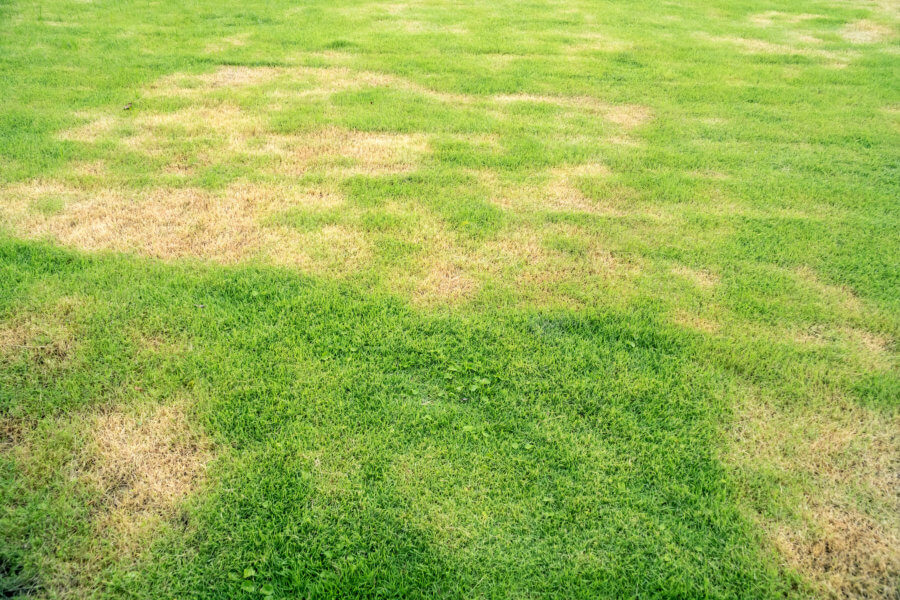
Chinch Bugs and Your Florida Lawn
Chinch bugs are among the most notorious pests that plague Florida lawns, particularly St. Augustine and Zoysia varieties. What makes these insects particularly tricky is that signs of their activity can closely resemble those of other common lawn pests and diseases. This can make it challenging to identify that chinch bugs are, in fact, the problem at hand.
Let’s take a closer look at these pests and what you can do about them before damage.
Chinch Bug Basics
When fully grown, chinch bugs are about the size of a grain of rice, which can make them difficult to spot in your grass. Adults are black with small wings, and the wings range from black to white, depending on the age of the bug. Nymphs, on the other hand, are bright orange with a white stripe horizontally crossing the back. Though adult chinch bugs have wings, they tend not to use them often.
It is important to be sure that you are dealing with chinch bugs before you begin treatment. They can closely resemble “big-eye” bugs, which actually eat chinch bugs and help keep them at bay. The last thing you want is to kill these beneficial bugs with pesticides simply because you misidentified them.
If you are unsure, check with a lawn care or pest control professional for confirmation.
Chinch bugs feed on the sap contained inside the grass blades. Over time, they will suck the blades dry, leaving dry, dead, and bare paths in your lawn. To spot chinch bugs, examine the area where the damaged blades meet the healthy grass. Look for nymphs and adults around the base of the stalks, as they love to hang out in the thatch. If you don’t see any chinch bugs, your lawn’s problem may be with another pest, disease, or over- or under-watering, which can present similarly.
Preventing Chinch Bug Infestations
The best way to keep chinch bugs out of your lawn is to prevent them from ever getting into it in the first place. Because they like to live in thatch, do your best to keep it from accumulating in your lawn. Keeping your lawn at an appropriate height for its specific variety will help as well. Finally, make sure you are providing the right amount of water to meet your lawn’s needs. Over- or under-watering can stress your lawn, making it more prone to infestations from chinch bugs and other pests. Stress also leaves your lawn more susceptible to diseases, so it is in your best interest to keep it as healthy as possible.
Getting Rid of Chinch Bugs
If chinch bugs have already taken up residence in your lawn, you’ll want to get rid of them as quickly as you can to prevent the infestation from spreading and taking over your entire lawn. Over time, Florida chinch bugs have developed resistance to many common chemical treatments. These treatments, even those specifically formulated for chinch bugs, can harm other bugs as well, including beneficial ones, so you should aim to use pesticides only as a last resort.
Your non-chemical treatment options include clearing out thatch, minimizing fertilizer use, and encouraging beneficial bugs to live in your lawn. If prevention methods aren’t enough to do the trick and you have to use pesticides, make sure that it is designed for chinch bugs. You’ll have plenty of options in this area, as chinch bugs are so common in Florida, so rotate which one you use with each treatment. This will help to combat any resistance the bugs may have so the treatments work more effectively.
Restore Your Lawn with Sod
If chinch bugs have done a number on your Florida lawn, the quickest, easiest way to restore it to health is to fill in any bare areas with fresh sod. Here at Duda Sod, our sod farms offer a wide range of grass varieties that tolerate the Florida climate with ease. These include Zoysia, St. Augustine, Floratam, and Bahia sod, to name a few. Our team will be more than happy to explain the pros and cons of our various sod types so you can make an informed decision about which is best for your lawn. Get in touch with us today to get started.